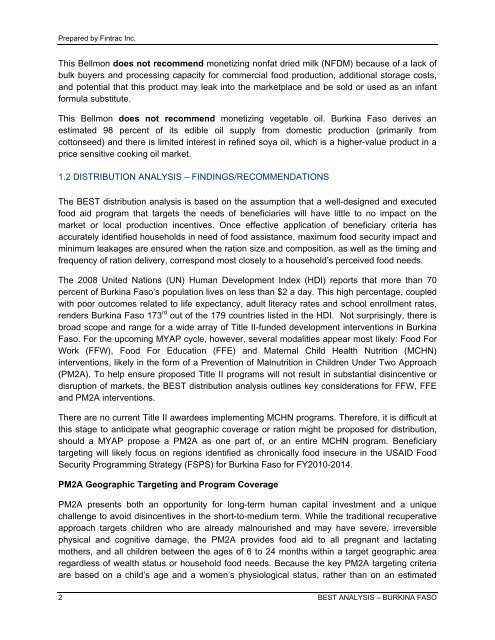USAID Office of Food for Peace Burkina Faso Bellmon ... - CiteSeerX
USAID Office of Food for Peace Burkina Faso Bellmon ... - CiteSeerX
USAID Office of Food for Peace Burkina Faso Bellmon ... - CiteSeerX
Create successful ePaper yourself
Turn your PDF publications into a flip-book with our unique Google optimized e-Paper software.
Prepared by Fintrac Inc.<br />
This <strong>Bellmon</strong> does not recommend monetizing nonfat dried milk (NFDM) because <strong>of</strong> a lack <strong>of</strong><br />
bulk buyers and processing capacity <strong>for</strong> commercial food production, additional storage costs,<br />
and potential that this product may leak into the marketplace and be sold or used as an infant<br />
<strong>for</strong>mula substitute.<br />
This <strong>Bellmon</strong> does not recommend monetizing vegetable oil. <strong>Burkina</strong> <strong>Faso</strong> derives an<br />
estimated 98 percent <strong>of</strong> its edible oil supply from domestic production (primarily from<br />
cottonseed) and there is limited interest in refined soya oil, which is a higher-value product in a<br />
price sensitive cooking oil market.<br />
1.2 DISTRIBUTION ANALYSIS – FINDINGS/RECOMMENDATIONS<br />
The BEST distribution analysis is based on the assumption that a well-designed and executed<br />
food aid program that targets the needs <strong>of</strong> beneficiaries will have little to no impact on the<br />
market or local production incentives. Once effective application <strong>of</strong> beneficiary criteria has<br />
accurately identified households in need <strong>of</strong> food assistance, maximum food security impact and<br />
minimum leakages are ensured when the ration size and composition, as well as the timing and<br />
frequency <strong>of</strong> ration delivery, correspond most closely to a household’s perceived food needs.<br />
The 2008 United Nations (UN) Human Development Index (HDI) reports that more than 70<br />
percent <strong>of</strong> <strong>Burkina</strong> <strong>Faso</strong>’s population lives on less than $2 a day. This high percentage, coupled<br />
with poor outcomes related to life expectancy, adult literacy rates and school enrollment rates,<br />
rd<br />
renders <strong>Burkina</strong> <strong>Faso</strong> 173 out <strong>of</strong> the 179 countries listed in the HDI. Not surprisingly, there is<br />
broad scope and range <strong>for</strong> a wide array <strong>of</strong> Title II-funded development interventions in <strong>Burkina</strong><br />
<strong>Faso</strong>. For the upcoming MYAP cycle, however, several modalities appear most likely: <strong>Food</strong> For<br />
Work (FFW), <strong>Food</strong> For Education (FFE) and Maternal Child Health Nutrition (MCHN)<br />
interventions, likely in the <strong>for</strong>m <strong>of</strong> a Prevention <strong>of</strong> Malnutrition in Children Under Two Approach<br />
(PM2A). To help ensure proposed Title II programs will not result in substantial disincentive or<br />
disruption <strong>of</strong> markets, the BEST distribution analysis outlines key considerations <strong>for</strong> FFW, FFE<br />
and PM2A interventions.<br />
There are no current Title II awardees implementing MCHN programs. There<strong>for</strong>e, it is difficult at<br />
this stage to anticipate what geographic coverage or ration might be proposed <strong>for</strong> distribution,<br />
should a MYAP propose a PM2A as one part <strong>of</strong>, or an entire MCHN program. Beneficiary<br />
targeting will likely focus on regions identified as chronically food insecure in the <strong>USAID</strong> <strong>Food</strong><br />
Security Programming Strategy (FSPS) <strong>for</strong> <strong>Burkina</strong> <strong>Faso</strong> <strong>for</strong> FY2010-2014.<br />
PM2A Geographic Targeting and Program Coverage<br />
PM2A presents both an opportunity <strong>for</strong> long-term human capital investment and a unique<br />
challenge to avoid disincentives in the short-to-medium term. While the traditional recuperative<br />
approach targets children who are already malnourished and may have severe, irreversible<br />
physical and cognitive damage, the PM2A provides food aid to all pregnant and lactating<br />
mothers, and all children between the ages <strong>of</strong> 6 to 24 months within a target geographic area<br />
regardless <strong>of</strong> wealth status or household food needs. Because the key PM2A targeting criteria<br />
are based on a child’s age and a women’s physiological status, rather than on an estimated<br />
2 BEST ANALYSIS – BURKINA FASO

















